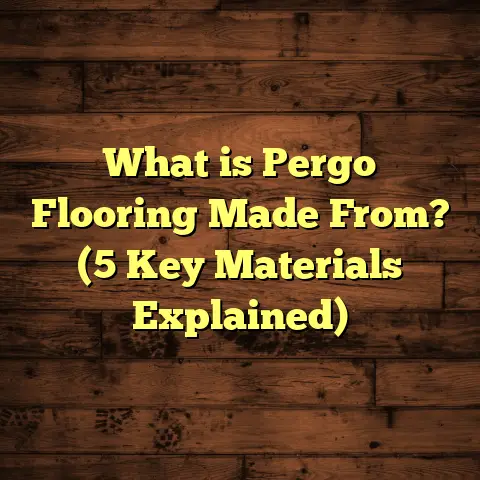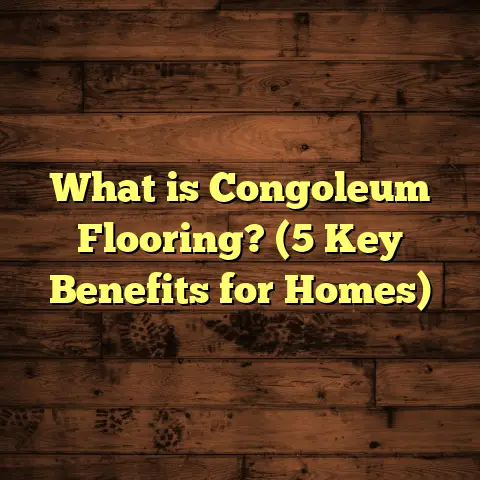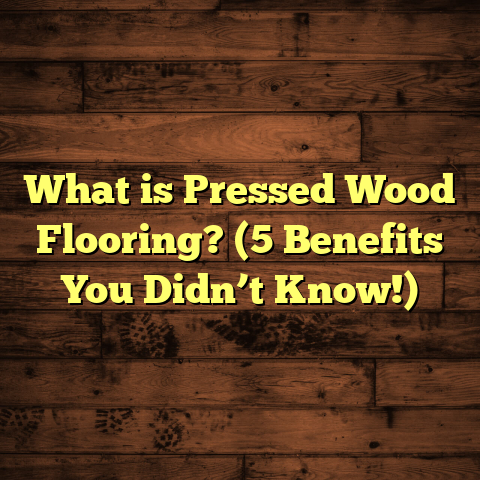What is a Two Story Extended Floor? (5 Key Benefits Explained)
Versatility is something I really value when it comes to home design. It’s what allows a house to adapt to changing needs and tastes over time. I’ve walked through many homes over the years as a flooring contractor and seen firsthand how versatile spaces can transform everyday living. One architectural feature I’ve grown especially fond of—and worked on quite a bit—is the two story extended floor. It’s a clever way to add space and style without sprawling outward on your lot.
If you’re thinking about expanding your home or just curious about unique designs, this might be something you want to know more about. What exactly is a two story extended floor? What benefits does it bring? I’ll break it down for you and share some stories and data that highlight why this option is becoming popular in many neighborhoods.
What Is a Two Story Extended Floor?
Let’s start with the basics: what is a two story extended floor? In simple terms, it’s when the second story of a home extends beyond the footprint of the first floor. Picture a house where the upper level sticks out over the ground floor, creating an overhang or cantilever.
This extension can be positioned at the front, back, or sides of the house depending on the design and site conditions. Rather than stacking one floor perfectly on top of the other, architects and builders use this technique to create more usable space upstairs without expanding the foundation.
From my experience working with clients who want more room but have limited lot sizes, this design perfectly balances vertical space with outdoor area preservation. It’s also a smart way to add character to a home’s exterior.
Let me share a quick example from a recent project:
A couple I worked with had a modest lot in a suburban area. They wanted a larger master suite but didn’t want to lose their backyard space or deal with complicated foundation work. We designed a second floor that extended about 6 feet over the back patio area. This gave them enough room for a sitting nook and walk-in closet upstairs while keeping their outdoor area intact for gardening and kids’ play space. It was a win-win.
Why Do People Choose Two Story Extended Floors?
You might wonder why this design is chosen instead of traditional building methods. Here are some common reasons I hear from homeowners:
- Lot size restrictions: If your property has zoning limits on how far you can build horizontally, extending upwards and beyond the first floor footprint helps maximize space legally.
- Cost efficiency: Expanding foundation work can be expensive. Sometimes extending just the upper floor reduces excavation and material costs.
- Aesthetic appeal: Overhangs and extensions create interesting shapes and shadows on a home’s exterior that many people find attractive.
- Outdoor space preservation: Keeping ground-level yards or patios free from building allows for better outdoor living.
- Improved views: Extending the upper floor may provide better sightlines over neighboring properties or natural scenery.
1. More Living Space Without Expanding the Footprint
One of the main reasons I recommend two story extended floors is how they add valuable living space without growing your home’s base.
If you’ve ever tried to increase your home size on a small lot, you know how tough it can be to squeeze in extra rooms without shrinking outdoor areas. With this type of extension, you gain extra square footage upstairs while leaving the first floor and yard untouched.
This is especially helpful in dense urban or suburban locations where every inch of land counts. Even adding 200-400 square feet on the second story can make a huge difference.
To back this up with some numbers:
According to data from the National Association of Home Builders (NAHB), adding 300 square feet of living space can increase home value by roughly $30,000 to $50,000 depending on location and quality of construction. This makes two story extended floors not just practical but also financially smart.
When I plan projects like these, I always measure how much extra room is gained upstairs versus how much outdoor space is saved. This helps clients visualize trade-offs clearly.
For example:
In one house I worked on recently in Texas, adding a second story extension increased bedroom size by 20% while preserving an existing garden area of about 500 square feet. The client was delighted because they got their dream master suite without sacrificing their favorite outdoor spot.
2. Enhanced Architectural Appeal
Let’s talk about looks now. A two story extended floor isn’t just about function; it also adds serious curb appeal.
From my viewpoint as someone who has seen many houses over years, homes with these features stand out because they break away from typical rectangular shapes. The overhangs create visual interest through shadows and lines that change with the sun throughout the day.
Many architects use this technique to emphasize modern or contemporary styles by incorporating clean horizontal planes or contrasting materials on the extension. You might see wood siding juxtaposed against stucco or stone cladding highlighting the extension area.
One memorable project was a mid-century modern renovation where we added an upper floor cantilevered 8 feet beyond the first floor at the front of the home. This created a dramatic floating effect that became the defining feature of the house. The owners said it made their home feel “architectural” and unique in their neighborhood.
Even in more traditional designs, these extensions can be softened with classic trimwork or decorative columns supporting the overhangs.
How It Can Affect Resale Value
Here’s something I’ve noticed from local real estate data: houses with distinctive architectural features like two story extensions often sell faster and sometimes at higher prices.
A 2021 study by Zillow showed homes with unique exterior designs sold about 10-15% faster than comparable cookie-cutter models in similar neighborhoods. Buyers appreciate homes that stand out visually but also offer functional benefits like extra space.
That said, it’s important to make sure your extension fits stylistically with your neighborhood unless you’re aiming for a bold statement.
3. Opportunities for Covered Outdoor Spaces
One benefit that often surprises people is the outdoor space created underneath an extended second story.
Because part of the upper floor juts beyond the first, it naturally forms a covered area below. This can be used as:
- A shaded patio for relaxing or dining
- A carport protecting vehicles from sun and rain
- Storage for bikes, gardening tools, or outdoor furniture
In climates with hot summers or frequent rain, having these covered outdoor spots makes a big difference in comfort and usability.
For example:
I helped a family in Florida turn their two story extension’s overhang into an outdoor lounging zone with weatherproof furniture and fans installed overhead. It quickly became their favorite hangout during summer evenings since it stayed cooler and dry even in storms.
These spaces can also increase usable living area without adding to your heating/cooling bills since they’re outdoors but protected.
4. Structural Considerations and Challenges
Now let’s get into some of the technical stuff that often comes up when building extended floors like this.
Because part of the second story extends beyond an open area without direct support underneath, special structural techniques are needed:
- Cantilever beams: These are horizontal beams anchored at one end that carry loads beyond supports. They allow part of the floor to “float” over empty space safely.
- Steel reinforcements: To handle weight efficiently especially for longer extensions, steel beams or columns may be incorporated within wooden framing.
- Load distribution: Engineers calculate how weight transfers from upper floors through beams and walls down to foundations to ensure stability.
These methods add complexity compared to stacking floors directly above each other but provide flexibility in design.
Cost Implications
Because of these structural requirements, building an extended second floor may cost more than traditional two-story construction per square foot. However, when you factor in saved foundation excavation and less ground disturbance, the overall project cost can balance out.
In my projects, I rely heavily on FloorTally to get accurate cost estimates early on. This tool lets me enter local labor rates, material choices, waste factors, and project specifics so I get realistic budget projections upfront.
Using FloorTally has helped me avoid underestimating costs related to steel beams or specialized engineering work—something I’ve seen happen too often when relying solely on rough estimates.
Safety Considerations
It’s critical that all extensions meet local building codes and safety standards. Improperly designed cantilevers can lead to structural failures down the line, so working with qualified architects and engineers is key.
I always recommend getting multiple professional opinions if you’re unsure about your design’s feasibility or cost before starting construction.
5. Increased Natural Light and Ventilation
Here’s another perk I’ve observed: extending the second story can boost natural light and airflow inside your home.
By pushing part of the upper floor outward, designers often add larger windows on multiple sides which let sunlight pour in from different angles during the day. This reduces reliance on artificial lighting—something many homeowners appreciate both economically and environmentally.
Also, since covered open spaces are created below extensions, air can circulate better around those spots improving ventilation indoors and out.
Real-Life Example
I once worked on a renovation where we added an upper floor extension with floor-to-ceiling windows overlooking a backyard garden. The owners reported feeling happier because their bedrooms felt brighter and airier than before when rooms were smaller and darker.
Studies back this up:
Research by Lawrence Berkeley National Laboratory found that increased daylight exposure improves mood and productivity while reducing energy bills by up to 20% through less need for electric lighting during daylight hours.
Case Study: My Experience With a Two Story Extended Floor Project
I want to share one detailed case study from my own work that highlights many of these benefits clearly:
Background
A young family approached me wanting more space for their growing kids but had only a narrow lot in an established neighborhood. They loved their garden but needed additional bedrooms plus an office for remote work.
Challenges
Building outwards wasn’t possible due to zoning setbacks limiting expansion near property lines. So we explored vertical options.
Solution
We designed a second story extended floor that projected about 7 feet beyond the rear wall of the ground floor covering part of existing patio space. This gave them two new bedrooms plus an office nook upstairs while preserving most of their backyard intact.
We incorporated:
- Cantilever beams engineered to support the overhang safely
- Large double-glazed windows for natural light
- Covered patio below used as outdoor dining area
Results
The family loved how much extra room they gained without losing outdoor space they treasured for barbecues and kids’ games. They also noted cooler temperatures under the covered patio during summer months making it usable more often.
Using FloorTally during planning allowed me to give them accurate upfront cost estimates including labor, materials like steel beams, wood flooring upstairs, and waste factors preventing over-ordering supplies.
The project finished on time and close to budget—always a win!
Some Financial Numbers To Keep In Mind
If you’re curious about costs related to two story extended floors, here are some ballpark figures based on my experience across different projects (costs vary widely by region):
| Aspect | Estimated Cost Range |
|---|---|
| Cantilever beam installation | $15 – $30 per linear foot |
| Additional framing materials | $25 – $50 per square foot |
| Exterior cladding/materials | $8 – $20 per square foot |
| Labor (framing + finishing) | $40 – $70 per hour (varies) |
| Structural engineering fees | $1,000 – $3,000 per project |
| Permits & inspections | $500 – $2,000 depending on locale |
These numbers reflect combined framing plus finishing upstairs but don’t include flooring installation itself—which varies by flooring type (hardwood, laminate, tile).
Using tools like FloorTally helps me adjust these costs based on real-time local data instead of guessing blindly.
Flooring Considerations for Two Story Extended Floors
Since I specialize in flooring too, here are some thoughts on selecting floors for these extensions:
- Weight matters: Heavier materials like stone or thick hardwood may require additional structural support in cantilevered areas compared to lighter options like laminate or engineered wood.
- Acoustics: Extended floors can amplify sound transmission between levels if not properly insulated beneath flooring surfaces using underlays or sound barriers.
- Thermal comfort: Floors with good insulation properties help keep rooms warm in winter and cool in summer especially when large windows are added alongside extensions.
- Durability: Kids’ rooms or offices might benefit from scratch-resistant surfaces such as luxury vinyl plank or high-quality laminate flooring that stand up well to heavy daily use but still look stylish.
In one project where we used engineered hardwood upstairs in an extended area, we noticed excellent dimensional stability despite seasonal temperature changes—a big plus compared to solid wood floors prone to warping under fluctuating humidity levels.
Final Thoughts from Years Working With Two Story Extended Floors
Looking back at dozens of projects involving two story extended floors across different climates and styles, I’m impressed by how versatile this design solution really is:
- It meets spatial needs creatively without sacrificing outdoor living
- Adds architectural flair that elevates curb appeal
- Offers practical covered outdoor spaces beneficial year-round
- Requires thoughtful engineering but pays off in functional gains
- Improves natural lighting & ventilation enhancing quality of life
Plus, from my contractor’s perspective using precise cost estimating tools like FloorTally makes budgeting straightforward which reduces stress for everyone involved.
This approach isn’t just for large custom homes either—smaller houses looking to grow efficiently benefit just as much if planned well early on.
I’m curious—have you seen any homes with these features where you live? Or maybe you’re considering an extension yourself? Feel free to ask questions! I’m happy to share what I’ve learned firsthand about making two story extended floors work beautifully for real families every day.





